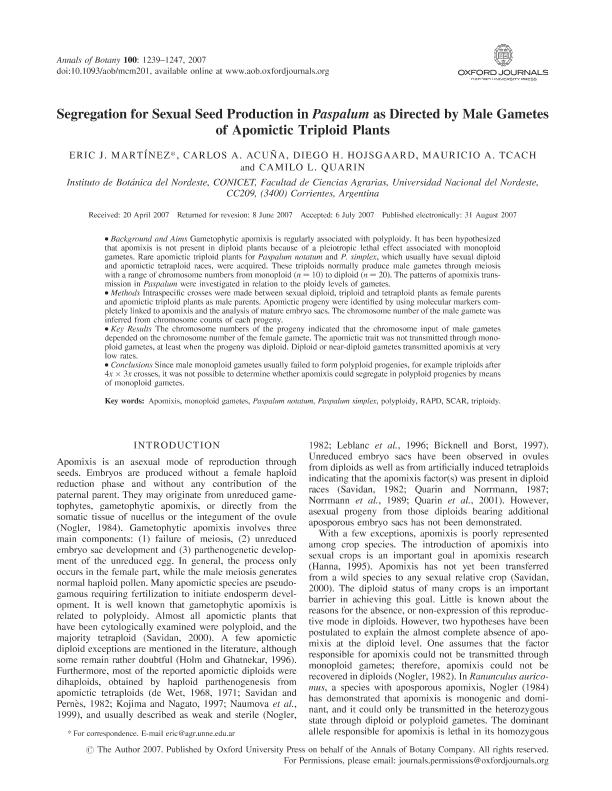Mostrar el registro sencillo del ítem
dc.contributor.author
Martínez, Eric Javier

dc.contributor.author
Acuña, Carlos Alberto

dc.contributor.author
Hojsgaard, Diego Hernan

dc.contributor.author
Tcach, Mauricio Alfredo

dc.contributor.author
Quarin, Camilo Luis

dc.date.available
2018-05-15T18:48:48Z
dc.date.issued
2007-09
dc.identifier.citation
Martínez, Eric Javier; Acuña, Carlos Alberto; Hojsgaard, Diego Hernan; Tcach, Mauricio Alfredo; Quarin, Camilo Luis; Segregation for Sexual Seed Production in Paspalum as Directed by Male Gametes of Apomictic Triploid Plants; Oxford University Press; Annals of Botany; 100; 6; 9-2007; 1239-1247
dc.identifier.issn
0305-7364
dc.identifier.uri
http://hdl.handle.net/11336/45232
dc.description.abstract
Background and Aims: Gametophytic apomixis is regularly associated with polyploidy. It has been hypothesized that apomixis is not present in diploid plants because of a pleiotropic lethal effect associated with monoploid gametes. Rare apomictic triploid plants for Paspalum notatum and P. simplex, which usually have sexual diploid and apomictic tetraploid races, were acquired. These triploids normally produce male gametes through meiosis with a range of chromosome numbers from monoploid (n = 10) to diploid (n = 20). The patterns of apomixis transmission in Paspalum were investigated in relation to the ploidy levels of gametes. Methods: Intraspecific crosses were made between sexual diploid, triploid and tetraploid plants as female parents and apomictic triploid plants as male parents. Apomictic progeny were identified by using molecular markers completely linked to apomixis and the analysis of mature embryo sacs. The chromosome number of the male gamete was inferred from chromosome counts of each progeny. Key Results: The chromosome numbers of the progeny indicated that the chromosome input of male gametes depended on the chromosome number of the female gamete. The apomictic trait was not transmitted through monoploid gametes, at least when the progeny was diploid. Diploid or near-diploid gametes transmitted apomixis at very low rates. Conclusions: Since male monoploid gametes usually failed to form polyploid progenies, for example triploids after 4x × 3x crosses, it was not possible to determine whether apomixis could segregate in polyploid progenies by means of monoploid gametes.- Methods Intraspecific crosses were made between sexual diploid, triploid and tetraploid plants as female parents and apomictic triploid plants as male parents. Apomictic progeny were identified by using molecular markers completely linked to apomixis and the analysis of mature embryo sacs. The chromosome number of the male gamete was inferred from chromosome counts of each progeny. - Key Results The chromosome numbers of the progeny indicated that the chromosome input of male gametes depended on the chromosome number of the female gamete. The apomictic trait was not transmitted through monoploid gametes, at least when the progeny was diploid. Diploid or near-diploid gametes transmitted apomixis at very low rates. - Conclusions Since male monoploid gametes usually failed to form polyploid progenies, for example triploids after 4x 3x crosses, it was not possible to determine whether apomixis could segregate in polyploid progenies by means of monoploid gametes
dc.format
application/pdf
dc.language.iso
eng
dc.publisher
Oxford University Press

dc.rights
info:eu-repo/semantics/openAccess
dc.rights.uri
https://creativecommons.org/licenses/by-nc-sa/2.5/ar/
dc.subject
APOMIXIS
dc.subject
MONOPLOID GAMETES
dc.subject
PASPALUM NOTATUM
dc.subject
PASPALUM SIMPLEX
dc.subject
POLYPLOIDY
dc.subject
RAPD
dc.subject
SCAR
dc.subject
TRIPLOIDY
dc.subject.classification
Ciencias de las Plantas, Botánica

dc.subject.classification
Ciencias Biológicas

dc.subject.classification
CIENCIAS NATURALES Y EXACTAS

dc.title
Segregation for Sexual Seed Production in Paspalum as Directed by Male Gametes of Apomictic Triploid Plants
dc.type
info:eu-repo/semantics/article
dc.type
info:ar-repo/semantics/artículo
dc.type
info:eu-repo/semantics/publishedVersion
dc.date.updated
2018-05-09T14:17:45Z
dc.identifier.eissn
1095-8290
dc.journal.volume
100
dc.journal.number
6
dc.journal.pagination
1239-1247
dc.journal.pais
Reino Unido

dc.journal.ciudad
Oxford
dc.description.fil
Fil: Martínez, Eric Javier. Consejo Nacional de Investigaciones Científicas y Técnicas. Centro Científico Tecnológico Conicet - Nordeste. Instituto de Botánica del Nordeste. Universidad Nacional del Nordeste. Facultad de Ciencias Agrarias. Instituto de Botánica del Nordeste; Argentina
dc.description.fil
Fil: Acuña, Carlos Alberto. Consejo Nacional de Investigaciones Científicas y Técnicas. Centro Científico Tecnológico Conicet - Nordeste. Instituto de Botánica del Nordeste. Universidad Nacional del Nordeste. Facultad de Ciencias Agrarias. Instituto de Botánica del Nordeste; Argentina
dc.description.fil
Fil: Hojsgaard, Diego Hernan. Consejo Nacional de Investigaciones Científicas y Técnicas. Centro Científico Tecnológico Conicet - Nordeste. Instituto de Botánica del Nordeste. Universidad Nacional del Nordeste. Facultad de Ciencias Agrarias. Instituto de Botánica del Nordeste; Argentina
dc.description.fil
Fil: Tcach, Mauricio Alfredo. Consejo Nacional de Investigaciones Científicas y Técnicas. Centro Científico Tecnológico Conicet - Nordeste. Instituto de Botánica del Nordeste. Universidad Nacional del Nordeste. Facultad de Ciencias Agrarias. Instituto de Botánica del Nordeste; Argentina
dc.description.fil
Fil: Quarin, Camilo Luis. Consejo Nacional de Investigaciones Científicas y Técnicas. Centro Científico Tecnológico Conicet - Nordeste. Instituto de Botánica del Nordeste. Universidad Nacional del Nordeste. Facultad de Ciencias Agrarias. Instituto de Botánica del Nordeste; Argentina
dc.journal.title
Annals of Botany

dc.relation.alternativeid
info:eu-repo/semantics/altIdentifier/doi/http://dx.doi.org/10.1093/aob/mcm201
dc.relation.alternativeid
info:eu-repo/semantics/altIdentifier/url/https://academic.oup.com/aob/article/100/6/1239/125631
Archivos asociados
